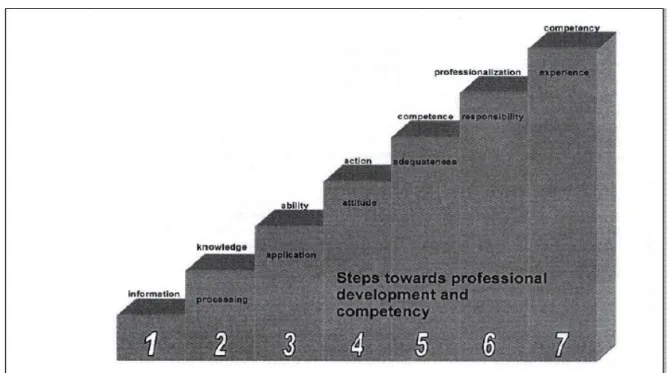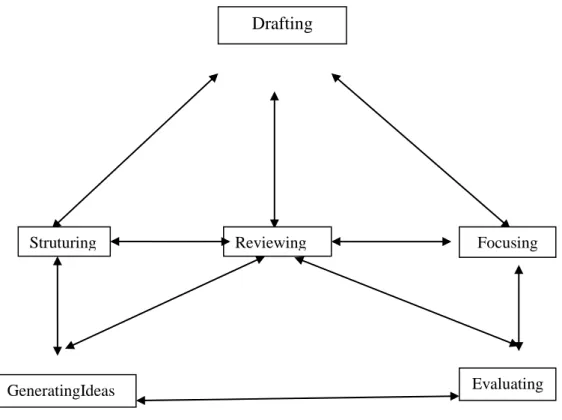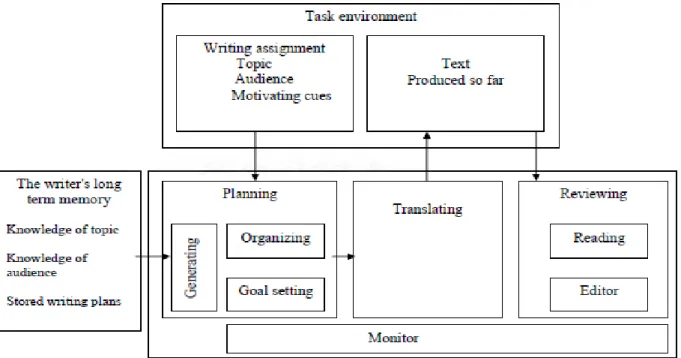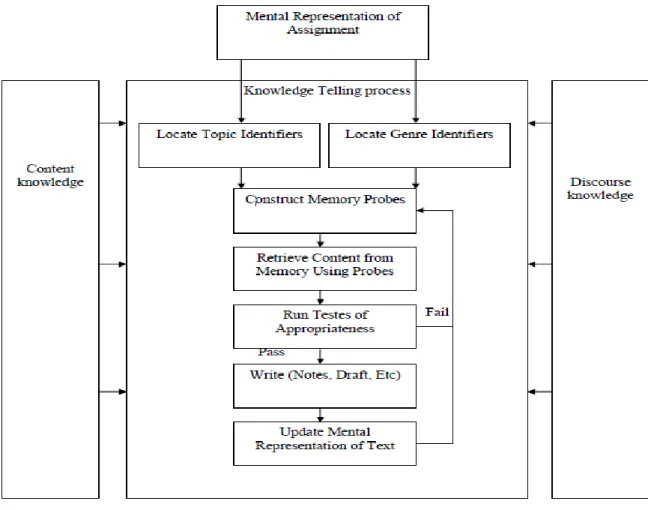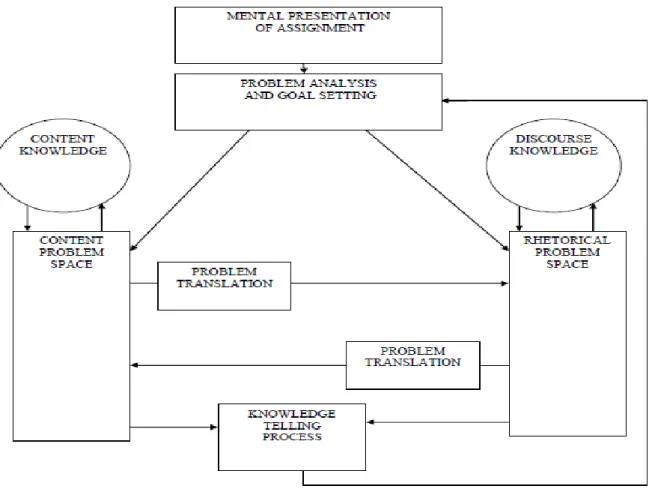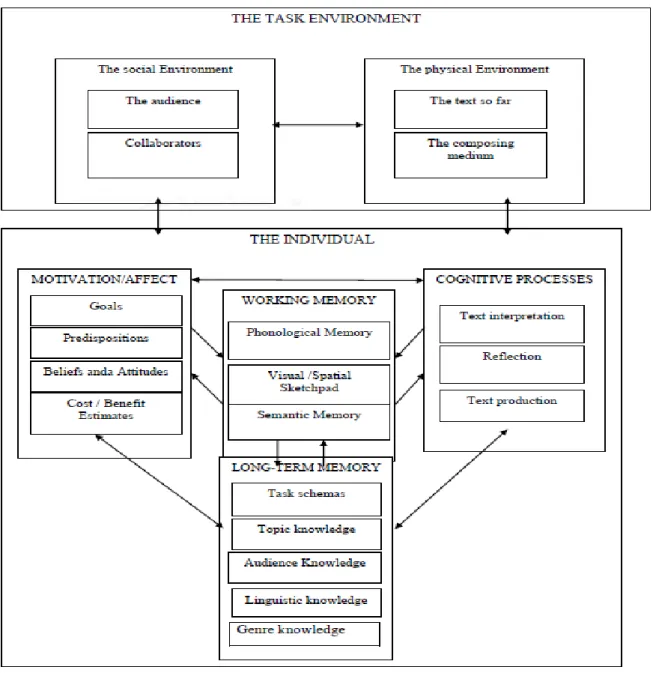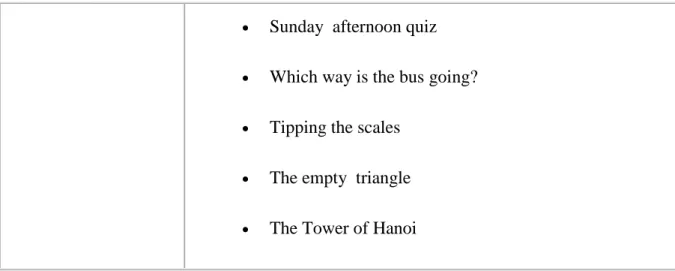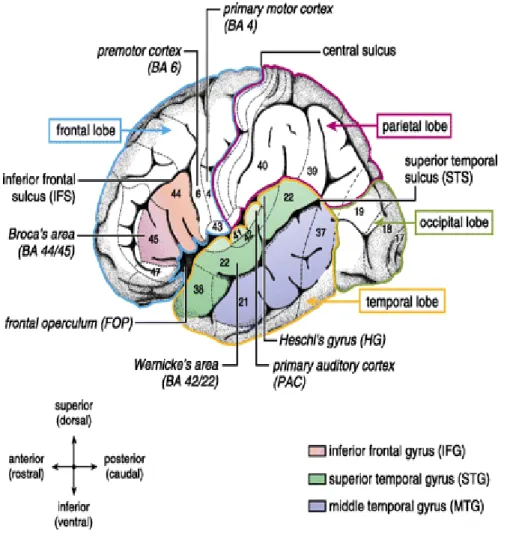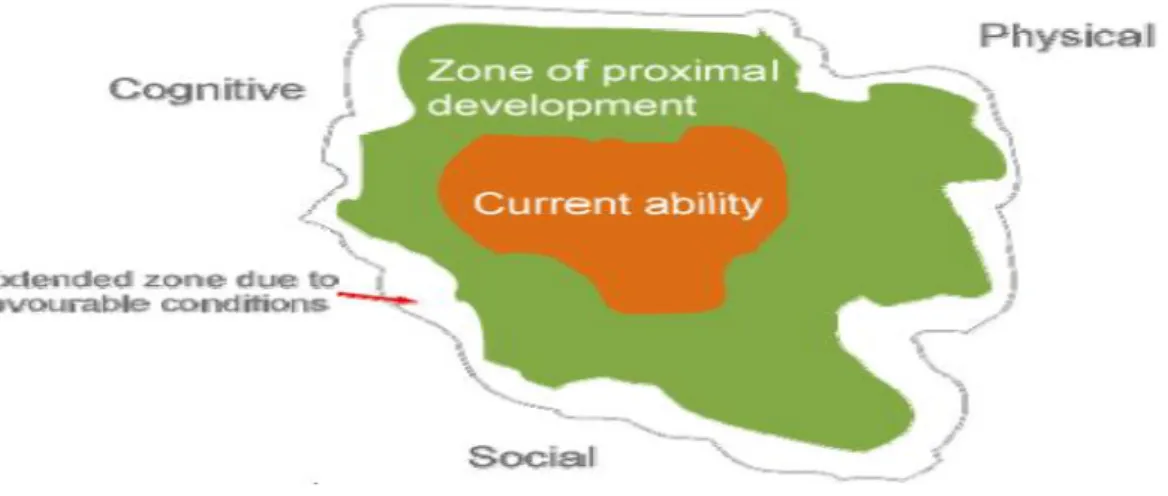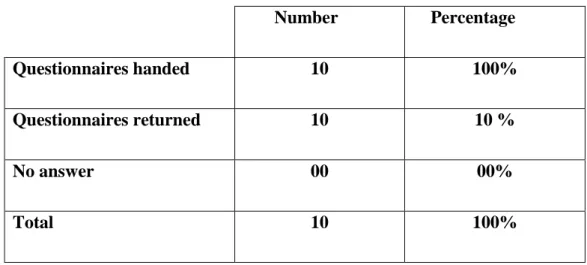PEOPLE'S DEMOCRATIC REPUBLIC OF ALGERIA
MINISTRY OF HIGHER EDUCATION AND SCIENTIFIC RESEARCH University of Djileli Liabes , Sidi Bel-Abbes
Faculty of Letters , Languages and Arts Department of English
A thesis submitted to the English language department for the requirements of the Doctorate Degree of Siences in: English Language Didactics
Submitted by:
Supervised by:
Mr.KABACHE Taieb Prof. GUERROUDJ Noureddine .UDL, SBA.
Board of Examiners :
Chairperson :Prof. Kaid F Berrahal. ENS Oran.
Examiner : Prof . Abbess Bahous . Mostaghanem University. Examiner :Prof .Ben Aissi Fawzia .UDL university SBA.
Examiner : Prof . Boulenouar Mohamed Yamine .UDL university SBA. Examiner : Dr . Neddar Belabbes . Mostaghanem University.
Academic Year 2016/2017
The Cognitive Effect of the Mother Tongue on EFL
Learners’ Written Production
Case study : First year students of English at ENS Laghouat
2013/2014
DEDICATION
I dedicate this humble work to the souls of my late
grandfather Hadj Aissa , grandmother Errebh and my
brother Atallah , to my family, my teachers, and my friends
without exception
.
Acknowledgement
First and foremost, I thank
Allah
who has offered me this chance to further my studies.
I would like to confess with much appreciation the vital role of my supervisor Prof.
Guerroudj Noureddine
,head of the Scientific Council of Djileli Liabess university,
whose permanent support and continuous guidance have ever been energizing me to accomplish
this work. I do also owe special thanks and expressions of gratitude to Prof..
Abbess
Bahous
who has been my supervisor in my Magister thesis. An expression of gratitude is
offered to
Prof.Kaid Fatiha Berrahal
, who has granted me a special back up
early at the beginning of my post-graduation period , I have to offer special thanks and
boundless recognition to the members of the jury : Prof. Ben Aissi Fawzia, Prof.
Boulenouar Mohamed Yamine and Dr.Neddar , who will devote much time
and effort in perusing my work….For those all I will be ever indebted.
At the end , I would like, in this occasion, to thank my colleague teachers who have
offered hands of help in carrying out this research notably
Mr.Ahmed Lamine
Kabache, Mr.Yahia Kabache and Mr.Daoudi Mourad.
ACKNOWLEDGEMENT
List of Abbreviations
CA: Contrastive Analysis
CBA: Competency based Approach CLT: Communicative Language Teaching EFL: English as a Foreign language EA: Error Analysis
ESL: English as a Second Language ESP: English for Specific Purposes ELT: English Language Teaching GA: Genre Approach
GTM: Grammar Translation Method L1: First Language
L2: Second Language M.T: Mother Tongue NL: Native Language PA: Product Approach PA: Process Approach
TEFL: Teaching English as a Foreign Language TL: Target Language
TESL: Teaching English as a Second Language
List of Tables
Table1:Pascale‘s classification of cognitive abilities ………..………...72
Table2: Interlanguage vs transfer…..……….………..…..…..103
Table3:Tense errors……….…………..…....109
Table 4 :Pronoun errors……….…………..….111
Table5: Articles‘ errors………...……….….112
Table6:Lexical errors………..…..………...114
Table7: Syntactic errors……….……...114
Table8: Advantages of piloting questionnaires…….…………..……….………..146
Table9: 1st Year (common core PEF / PES) Official Modules……….…...155
Table10:Representation of the teachers' questionnaire submission………..…...163
Table 11 :Institutions……….………..…..166
Table12 :Modules taught………...………....167
Table 13: Informants‘ level in their L1……….……...…169
Table14: Participants‘ views about the importance of writing………..…………..…..174
Table 15: Participants‘ views about the priority of writing upon the other skills…...…177
Table 16: Participants‘ views concerning teaching writing implicitly through the other skills ……….179
Table 17: Teachers‘ views concerning the writing process ……...………...181
Table 18: Teachers‘ views concerning the obstacles facing their learners while writing…..182
Table 19:Participants‘ views concerning the influence exerted by L1 on L2………...…184
Table 20:Participants‘ views concerning the use of L1 regardless of frequency…………..187
Table 21: Teachers‘ views concerning their students‘ tendency towards relying on their mother tongue/ national language(Arabic)when writing in English……..…………...….189
Table 23: Teachers‘ views concerning L1 cognitive effect………...194
Table 24: Teachers‘ views concerning interlanguage awareness &learners‘ performance...195
Table 25: Teachers‘ arguments concerning immediate interference………...………..196
Table 26: Teachers‘ views concerning devoting special contrastive sessions…………...197
Table 27: Learners‘ questionnaire………..………...…200
Table 28 :Learners and mastery of languages……….……….…203
Table 29: Participants‘ choice as English language teachers………..…..…………205
Table 30: Participants‘ reasons for studying English out of academic settings……..…….206
List of Figures
Figure1: Steps towards professional development and competency……….…….…21
Figure 2: White and Arndt's stages of writing process (1991)……….…..49
Figure 3: The Hayes- flower 1980 Writing model……….……...53
Figure 4: Structure of the Knowledge telling model Bereiter and Scardamalia( 1987)……..55
Figure5:Structure of the Knowledge -transforming model Bereiter and Scardamalia( 1987).…. 57 Figure 6: The Hayes‘ model ( 1996)……….……….………61
Figure 7: Language nervous zone………...77
Figure 8: Nemser‘s Approximative systems……….………102
Figure 9: Vygotsky's Zone of Proximal Development……….122
Figure 10: Teachers‘ Gender ….……….………..164
Figure 11: Teachers‘ Grades……….……….………165
Figure 12 :Teachers‘ Experience……….………...166
Figure 13: Teachers‘BAC Stream………..………..168
Figure 14: Adopted teaching approaches………..…………..……...170
Figure 15 ꞉Teachers‘ views about teaching a foreign language ………….………..…171
Figure 16: Learning a language as a communicative or as a grammatical competence…....173
Figure 17: Focused- on teaching skills………..………..…….174
Figure 18: Approaches to teaching writing……….…….….176
Figure 19:The Implicit teaching of writing through other skills………...…...….178
Figure 20: Teachers‘ views concerning types of writing tasks exposed to pupils….……...180
Figure 21: Teachers‘ views about learners‘ writing obstacles………..…….…..181
Figure 22: Basis of assessing or evaluating students‘ progress in their writing Compositions……….183
Figure 24 : L1 impact ………..……….185
Figure 25 :Informants‘ L1 immersion……….………….……….…………186
Figure 26 :L1 use reasons……….……….………….………187
Figure 27:Level of L1 effect……….……….…………188
Figure 28 :L1 and affected writing levels……….……….………189
Figure 29: Learners‘ reasons for using L1………..………….……….…190
Figure 30 :Learners‘ interference awareness………...……….………….191
Figure 31 :L1 Interference : positive or negative……….……….192
Figure 32 :L1 Cognitive effect……….……….193
Figure 33:Interlanguage awareness &learners‘ performance………..194
Figure 34 :Remedial Work………...196
Figure 35 :More L2 practice or contrastive method……..……….…..…………198
Figure 36: Contrastive method effect on L2 writing……….……….…………199
Figure 37 :Learners‘ Gender………201
Figure 38 :Learners‘ BAC streams……….…….…………202
Figure 39 :Learners‘ English speciality: chosen or imposed………..……….……204
Figure 40: Studying English out of academic settings………...………...206
Figure 41 :Learners‘favourite teacher………...……..………...…207
Figure 42: Learners‘ most important skill……..……….……….208
Figure 43: Difficult skills to handle……….………209
Figure: 44 : Means to improve writing………...……….………210
Figure 45: Learners‘ L1 level………..……….211
Figure 46:Learners‘ L1 readability……….……….212
Figure 47 :Learners‘ attitude towards L1 Immersion………...………213
Figure 48:Learners‘ interlanguage awareness……….………215
Figure 50: Learners‘ self-evaluation about L2 compared to L1………..………...….217
Figure 51:Learners‘ writing obstacles……….….218
Figure 52: Learners‘ reliance on L1………...…..…219
Figure 53: Learners‘ reasons for L1 use……….………..…220
Figure 54: Learners‘ feedback about CA utility………...…221
Figure 55:Learners‘ errors self-recognition ………..……….….…222
Figure 56: Learners‘ errors detection ………..…223
Figure 57: Learners‘ errors reasons………...……...224
Figure 58: Learners‘ wants about the evaluation of their writing ………..………..………225
Figure 59: Learners‘ ideas/words transmission………..…..…226
Figure 60 : Learners‘ attitudes towards reviewing , revising and peer editing……….227
Table of Contents
Dedication
………...IAcknowledgment
……….…IIList of Abbreviations
………IIIList of Tables
………...IVList of Figures
………...VITable of Contents
….………...IX
Abstract………...XV
General Introduction
………..………...….1
Purpose of the Study
………..……….……….3
Research Questions
……….….3
Hypotheses
……….……….4
Limitations of the Study
……….…...….4
Organization of the Study
……….………..……..5Chapter One: Approaches to Language Teaching
1. Introduction………..………...92. Grammar Translation Method……….………9
3. Communicative Language Teaching (CLT)………...………….13
3.1 Communicative Competence……….………...16
3.2 Principles of CLT ………..………...17
4. Competency -based Approach (CBA)………..………18
Chapter Two: Approaches to Teaching Writing
1. Introduction………...…26
2. The Essence of the Writing Skill………27
3. The Role of Writing in Second/ Foreign Language………...…31
4. Written versus Spoken Language………...34
5. Writing and Reading ………...39
6. Adopted Approaches to Writing……….41
6.1. The Product Approach……….……..43
6.2. The Process Approach……….………...45
6.2.1 The Tenet of the Process Approach………50
6.2.2. Models of the Process Approach.………...52
6.2.2.1. Hayes and Flower (1980)……….………..…52
6.2.2.2. Bereiter and Scardamalia (1987)……..………....…...54
6.2.2.3. Hayes (1996)………….……….………....…58
6.2.3. Stages of the Process approach…….………...…..…...61
6.2.3.1. Prewriting………..62
6.2.3.2. Drafting……….………....63
6.2.3.3. Revising……….64
6.2.3.4. Editing….……….………64
6.2.3.5. Publishing……….….65
6.3. The Genre Approach………..………..……..66
Chapter Three: Human Language Cognitive System
1. Introduction………...……….…...70
2. The Nature of Cognition……….……….……..……..71
3. Cognitive Abilities………..……….….71
4. Cognitive Strategies……….……….……75
5. Meta-cognitive Strategies……….……76
6. Language Nervous Zone……….……….…….76
7. Piaget and Cognitive Development ………..……78
7.1 Sensory-motor Stage……….……….…80
7.1.1 From Birth to First Month………...…...80
7.1.2 From First to Four Months………..……….……..80
7.1.3 From Five to Eight Months……….………...…81
7.1.4 From Eight to Twelve Months………..……….……82
7.1.5 From Twelve to Eighteen Months………...…...82
7.1.6 From Eighteen till Twenty Four Months……….……...…82
7.2 Preoperational Stage……….…………...…83
7.3 Concrete Operational Stage………..……….…84
8. Language and Cognition……….…………..…84
9. Cognition and Interlanguage Theory……….………...…86
10. The Cognitive Approach to Language Learning……….………87
Chapter Four: Interlanguage, Transfer and Second Language Acquisition
1. Introduction………...……….….…..93
2. Native Language/Mother Tongue and National Language……….……….…...94
3. Languages in Algeria and the Current Study………....95
4. The Concept of Transfer……….….………...……....95
5. The Concept of Interlanguage……….………….…………...…..98
5.1 Selinker and Interlanguage………98
5.2 Nemser‘s Approximative Systems ………..………...101
6. The difference between Transfer and Interlanguage………..…………..…..102
7. Interlanguage Awareness………..….104
8. Interlanguage and writing Errors………..………...…105
9. The Importance of Error Analysis ( EA)……….……….…...106
9.1 Errors versus Mistakes………...108
10. Participantsof the study‘s writing errors……….……….…..…………...109
10.1 Grammatical Errors………..…...109
10.2 Lexical and Meaning Errors……….…………...113
10.3 Syntactic Errors……….…..…...…...114
11. The Role of Contrastive Analysis ( CA)…………..…………..………...114
12. Language Interference Approaches……….………..…….116
12.1 The Cognitive Approach………...116
12.2 The Behaviourist Approach……….119
12.2.1 Old Behaviourist Attitude……….………...…….119
12.2.2 Current Behaviourist Attitude ………..119
12.3 Social Psychology and Sociolinguistic Approaches……….………..……120
13. Conclusion………..123
Chapter Five: The Study’s Methodology Design
1. Introduction………...………....…...1252. Research Methods and their Relatedness to the Study………127
3. The Study‘s experimental Method………....……...…136
4. Data Collection Techniques and the Current Study………...…...…..140
4.1 The Observation ……….……….…...141
4.2 The Interview ……….…..…………....142
4.3 The Survey ………...……...…...142
4.4 The Schedules ……….……..…...…..143
4.5 The Document Review ……….………..………...…….144
4.6 The Questionnaire………..…...144
5. Piloting the Questionnaire………....145
6. Teachers‘ Questionnaire………..…….……..…..146
7. Learners‘ Questionnaire………..……...…..147
8. Validity of the Study………...….147
9. Reliability of the Study………...…...148
10. Variables………..………...…....149
11. Population and Sampling ………..…..……150
12. Data Analysis Processes……….…….154
13. The Context of the Study and Limitations………...155
14. Reporting Findings………..……….156
Chapter Six: Findings Analysis
1. Introduction……….………...159
2. Purpose of the Study………..………....160
3. Teachers‘ Questionnaire Structure ………..……….…160
4. Presentation and Interpretation of Teachers‘ Questionnaire Results………....163
5. Learners‘ Questionnaire Structure………..…199
6. Presentation and Interpretation of learners‘ Questionnaire Results………..….200
7. Conclusion………..……..….229
General Conclusion………230
Glossary of Key Terms
Bibliography
Abstract
Learning a language is agreed upon to be a human feature that requires conformity to the sophisticated nature of human beings' mental and cognitive abilities. Bearing in mind the undeniable existence of the mother tongue, several attempts have been generated to better enlighten this nook of knowledge. Since the endeavours of Uriel Weinreich in the fifties of the last century, the view towards acquiring the second language has been familiarized clearly and most notably with the work of Larry Selinker 1972, whose work broke out endless debate about interlanguage. In the light of the current teaching approaches and conclusions , it has been noticed that one of the main difficulties EFL learners face ,whenever they want to write, is tending to think in their mother tongue / national language and then translate into the English language, this makes them unable to find the equivalent in the target language . In fact, the overwhelming majority of learners fall in the trap and fail to express their ideas, simply because they are not aware enough that their level in their mother tongue is relatively higher than the English one . This work which targeted first year English language students at Laghouat ENS in the academic year 2013/2014 had been launched by gathering the required raw material of learners‘ writing errors through error analysis (EA), the researcher then applied the proposed remedy in the form of contrastive analysis (CA) in between L1 and L2 for the sake of raising participants‘ interlanguage awareness.
Findings of such a research have revealed that most of learners are not aware of this linguistic interference on the one hand. On the other hand, the insertion of a contrastive analysis has proved to be of a vital impact in creating a certain degree of awareness for learners in the focus group whose errors have been diminished to 56 percent ,in contrast to the control group whose errors decreased with roughly 20 percent.
Eventually, the current work with its adopted tools and strategies seems to have contributed, at least partially, to lessening the degree of sharpness of the interlanguage influence for those learners at the level of their written production , though it can never be considered as the sole obstacle that undermines EFL learners‘ written production.
General Introduction
The teaching process has for a long time been a rich field of research and a very profound aspect for scholars' concern, since it is related to human beings , whose nature is evolution and progress, especially their language which is considered to be one human distinctive feature when compared to other creatures' languages. These which are characterized by stability and constancy due to their limited needs-based nature .Thus, teaching a language requires endless updated methodologies and materials that should meet learners‘ life needs.
The field of teaching foreign languages has ever been witnessing tremendous changes due to the continuous endeavours and approaches that have been launched for the sake of facilitating the task of learning and then mastering languages other than learners‘ own ones. As a matter of fact, teaching a language for non-native learners represents a real challenge that requires much more effort and attention, since it has the nature of being a totally alien tongue for the learners. Those learners, who might have less chance to practice this language, and if found it must be deprived of its other living side ―culture‖. This is apart from the current new era that witnesses a titanic technological revolution which has left no room for being a foreigner via its sophisticated techniques.
So, teaching a foreign language has to be viewed as a special language teaching so that to assume the responsibility of providing learners with the required means that enable them achieve certain efficiency in the target language. English as a Foreign Language (EFL) has for long time been a fertile land for several approaches starting with the Grammar Translation Method (GTM), till the most recent ones: communicative language teaching (CLT) and competency-based approach ( CBA).
It is a fact that teaching writing in particular has had the largest pie of research and witnessed several improvement attempts , including mainly the Product Approach , the Genre Approach and the most adopted one : The Process Approach .
The basic concern of this study is entirely devoted to such important linguistic skill; writing, due to several reasons which have helped in boosting the plan of this work, notably: 1-Teachers of modules other than writing do continuously suffer from certain weaknesses that mar learners‘ writing at several language levels like: grammar/syntax, vocabulary and lexical choice.
2-During my teaching career especially the days of secondary school and precisely in the writing phase , I always obviously notice that some learners are motivated to write and develop the assignment they are instructed to do , however when gazing into their faces I could identify the frightening look of lost children , they were saying in themselves that they were caught in something they did not understand , perhaps that fellow teachers might help them out of that dilemma.
For the reason of highlighting the nature of teaching writing in English as a foreign language and the cognitive effect of L1, an experiment has been carried out at the level of ENS Laghouat Algeria , first year students targeting the productive skill: the written expression module , the number of students is 60 (8 masculine 52 feminine ) forming two balanced groups: thirty students each, during the academic year 2013/2014. The allotted time is three sessions, one hour and half each with an overall of four hours and a half per week. The principle of the experiment was first to supply only participants of the focus group with a variety of writing tasks for the sake of gathering enough data in the form of errors of L1 nature, followed by a contrastive analysis where necessary. Once those errors have been detected and classified, the next stage was to make the first group aware of the linguistic differences between the two languages (contrastive analysis) this procedure covered the
whole first semester ( more than six months: mid-September , 2013 till April 15th , 2014) , and only then we could recognize the importance of this cognitive aspect ; learners awareness of this linguistic phenomenon through supplying learners again with a variety of tasks that looked like those which they have been exposed to during the first phase of collecting errors . In evidence, it should be noted here that the use of the mother tongue is not a matter of choice; rather it is referred to as a compulsion that can never be averted, but rather dealt with. Simply because of the L1 cognitive and mental components which have been implanted since childhood. EFL learners then, need to be made aware that there exist several factors that should be taken into account whenever producing in a second language, and here only they may grasp the intended meaning most of the time easily.
Purpose of the Study
EFL classrooms are most of the time heterogeneous , i.e.; they include learners who may exhibit a variety of linguistic levels and this leads to the existence of many types of errors .The present study emphasizes a cognitive approach to FL writing problems , through its main purpose which is to diagnose the effect of interlanguage awareness on EFL learners‘ written production , adopting a contrastive analysis as a strategy.
The ultimate aim of this work is to come at an identification and diagnosis of the inter- language defects caused by L1 as an independent variable on learners‘ writing as a dependent variable, this which leads to the presence of writing errors. This, all aims at suggesting a remedial approach in the form a mixture between error and contrastive analyses.
Research Questions
To foster this endeavour ,three main questions have been formulated:
1-Are EFL learners ( 1st year students at the ENS of Laghouat ) aware of L1 /L2 interference ?
2. If so, can they totally prevent their mother tongue‘s interference at the level of their writing if equipped with CA and made aware of such interference?
3-Does this cognitive factor of awareness consist the sole obstacle that hampers them from writing efficiently?
Hypotheses
The above-cited composed questions have been followed by three basic views which have been hypothesized:
1. Most of EFL learners (1st year students at the ENS) are unaware of the existence of interlanguage components when writing in English that is why they commit errors.
2. If they are made conscious of such a fact, and supplied with an accurate contrastive view in between L1 and L2, their written production will be relatively pure of interference errors.
3. Interlanguage awareness seems to be the most prominent factor that undermines learners‘ written production.
Limitations of the Study
As it is the case in any academic study , there is a variety of limitations that occur within this work .First , the number of correspondents is relatively limited , simply because the number of students at the ENS in general is expected to be small , as learners are promised to sign working contracts once they enroll .Second , teachers who tend to adopt and apply the strategy suggested by this study may not all be equipped with the necessary linguistic knowledge of L1 though they may use it , this does not permit them to apply a comparative view which functions as the fuel towards achieving linguistic awareness recommended in this study .Lastly, limitation refers to the sensibility of using L1 in classrooms , due to the fact that some teachers tend not to permit the use of L1 in classrooms whatever the reasons are neither for themselves nor for their students .
Organization of the Study
This work is initiated by a general introduction that embodies hints on the theoretical background that touch the variables of the whole work through six chapters , that explore the two variables and exhibit the adopted method that led to the gained findings.
The first chapter deals with the preliminary approaches that prevailed the teaching- learning domains from the outburst until nowadays. This chapter then entails those teaching approaches in a chronological order thus starting with Grammar Translation Method (GTM), Communicative Language Teaching (CLT) , and concluding with the competency Based Approach (CBA). In this chapter also , the researcher sought to provide clear cut differences between such approaches as well as to demonstrate how one approach , although seemingly having divergent nature with one another, makes a platform to another eventual approach , simply by assuring the utility or the malfunctioning of its comprising key elements. To add, this chapter then singles out the approaches which seem to be of vital importance to our current study.
The Second chapter contains an over view about the theoretical angles relevant to the dependent variable of the study: ―Writing‖. In particular , this part deals with the well-known and mostly adopted approaches to teaching writing , so as to gain a clear image about the essence of this study , simply because the researcher wants to shed light on one way of how to teach writing , through this view that definitely needs to be explored and invested by future researchers .The chapter begins with the product approach, then the genre approach till coming at the process approach .This latter is thought to be the most adopted one, as it imposes certain steps to be followed in the written production to better prevent possible errors especially in EFL contexts for instance Algeria .
The third chapter has been entirely devoted to the basic independent variable which is about cognition and language , this seeks to show the nature of the human language as a
cognitive behaviour together with some reference to the other human cognitive abilities . It starts with localizing language system in the human brain, then specifying the performance of the language perception and production, supporting this with certain maxims notably Piaget‘s views about this aspect. This chapter tackles the literature review related to the independent variable of the study: cognition and language awareness. This tends to show the utility of this independent variable which functions as a main pillar that affects the target variable. This is followed by a discussion of the cognitive nature of language, language and the nervous zone, and more importantly interlanguage awareness.
The fourth chapter is concerned mainly with certain theoretical considerations about the first language, interlanguage or language transfer together with its different levels .In this chapter also we find some theoretical notions about the current approaches to language transfer including contrastive analysis and error analysis basically. This chapter functions as a corner stone to this work, for it is related to the first variable which is the cognitive effect of the mother tongue.
The fifth chapter of the study is thoroughly consecrated to the methodology design that has been picked out of a set of available ones, together with certain arguments related to the appropriateness to the nature of the study. However, this all has been preceded by a comprehensive picture that offers the different available research methods and the inappropriateness of each one to the type of this work, coming at the most pertinent one that has been judged to be the most suitable one for the current study in the form of a hybrid between quantitative and qualitative methods .
The work then, reaches a crucial stage that preoccupies the researcher‘s concern and pervades the lion‘s share from the whole work through the chapter that involves presentation and interpretation of results, when exhibits the findings reaped by both the experiment and the questionnaires, highlighting each item separately, analyzing its result with comments and
comparing it to other items and then relating it to its convenient variable, research question or hypothesis .
This dissertation is ended by a general conclusion that sum up the main points about interlanguage and the writing skill dealt with throughout the whole endeavour .It also restates certain findings relevant to answering the research questions and supporting the raised hypotheses .The conclusion further more evaluates and comments on the whole work and invites other researchers to further develop the study and enrich its dimensions. Eventually and simultaneously, the researcher has also constructed certain views in the form of a handful of recommendations relevant to the work which may serve as a helping tool for future field workers in the same field of interest.
Chapter One: Approaches to Language Teaching
1. Introduction………...9
2. Grammar Translation Method……….………9 3. Communicative Language Teaching (CLT)………...…….…….13 3.1 Communicative Competence……….………...16 3.2 Principles of CLT ………...………....17 4. Competency -based Approach (CBA)………..………18 5. Conclusion………23
1. Introduction
Human beings are characterized by the feature of being keen on discovering the world around them and seeking to develop their means of communication. Centuries before the appearance of any science related to language, human languages were all dependent on other disciplines like logic and philosophy. They were focusing only on written aspects of language through borrowed models of analysis imposed by arm-chair grammarians who were just prescribing rules of grammatical items in isolation. That context paved the way for the appearance of the first endeavor of teaching languages named the Grammar Translation Method. However, with the emergence of modern linguistics early at the beginning of the twentieth century with the founding father F.D Saussure (1857-1913), language had drawn its path towards independence, becoming self-sufficient through the science of linguistics, which views language as a system of systems that focuses on both written and spoken aspects of language in a descriptive rather than prescriptive manner. This came to be known later as ‗structuralism‘.
That all created an appropriate context for language teaching innovation which gave birth to a succession of multiple teaching approaches namely: the direct method, audio-lingual method, oral situational method, and the communicative method together with competency based method.
2. Grammar Translation Method
The Grammar Translation Method (GTM) pioneered the scene of foreign language teaching for almost a century ago, (1840s- 1940s), so it is the first method in the domain. Historically speaking, this method was used to teaching Greek and Latin. Then it was generalized to foreign languages. Though its use is relatively remote in the history of language teaching, in fact, it is still popular or even utilized in some countries nowadays. This is closely related to our research in its independent variable ; the cognitive effect of the mother tongue . As the name suggests, it clearly focuses on grammar, i.e. grammatical competence. So, what is meant by grammatical competence and how is it realized? According to Richards (2006: 3):
Grammatical competence refers to the knowledge we have of a language that accounts for our ability to produce sentences in a language. It refers to knowledge of building blocks of sentences (e.g. parts of speech, tenses, phrases, clauses, sentence patterns) and how sentences are formed.
Language learning, then, is limited to ‗knowledge of grammar rules‘ which leads us to the second principle of GTM. It is the isolation of grammar rules considering other elements of a language as secondary or of negligible outcomes. The mastery of grammar is an indicator of language competency or use. In this context,( Boumová2008:10)arguesthat:
Traditional methodology is based largely on a reduction of the integrated process of using a foreign language into sub-sets of discrete skills and areas of knowledge. It is largely a functional procedure which focuses on skills and areas of knowledge in isolation
Another principle of GTM teaching-learning is that those grammar rules are to be taught deductively. Learners are supposed to be ―passively‖ in full attention, so as detailed instructions and explanations are poured by teachers. This leads us to another tenet of GTM,
which is the centrality of the teacher. The teacher is seen as the authority and the source of knowledge that learners listen to attentively.
Teaching grammatical rules would be through reading only, i.e. the exclusion of listening and speaking from the process of learning is another maxim of the Grammar Translation Method. Once those grammatical rules are learnt, they are supposed to be put in situations so as to be practiced, but this practice would be in writing only .Ronald V.White in his book ―The ELT Curriculum‖ clarifies this opinion saying that ―there is no oral or pronunciation work, since it is the written language which is taught, and ‗mental discipline‘ is stressed rather than any ability actually to use the language‖ Boumová (2008:14). Concerning mental ability, to add, the Grammar Translation Method works on developing learners‘ minds and that is manifested through two aspects. The first one is through using the first language as a reference to learn grammatical rules, which mutually enables learners to unconsciously compare those different grammatical rules and put them under continuant judgment as linked to their first language, thus enabling them not only to learn L2 grammatical rules , but also to enhance theirs. In this case, Gascoigne C ( qtd in Arrouf2009:12)argues that:
In grammar translation, the development of the mind, as well as of translation skills, was accomplished through a deductive form of teaching, moving from the statement of the rule to the example. In the classroom, the student was a passive recipient of rules and engaged in practice activities and translation exercises requiring the application of explicit grammar rules
During learning a language, the GTM highlights that there is no room for errors since they might develop to male uses of grammar, language. In her published thesis, Bc.Viera Boumová ( 2008 :16 ) asserts that :
Good habits are formed by having students produce correct sentences and not through making mistakes. Errors were to be avoided through controlled opportunities for production (either written or spoken). Accurate mastery was
stressed from the very beginning stages of language learning, since it was assumed that if students made errors these would quickly become a permanent part of the learner‘s speech.
This is clearly a behaviorist attitude towards language learning that is as linguistic theories pass on, proves to be of less validity. Chomsky, on his part as a pioneer of the mentalist school of language learning and teaching, refutes this claim considering errors as indications of progress ―learning‖. Other differing notions involve ―structuralism‖ as well. Those differences might be highlighted as follows.
While Traditional grammar prioritizes written language, structuralism does otherwise. Unlike the Traditional Grammar prescriptive attitude concerning language, structuralism is a descriptive one. They think if we want to study language, we must describe language first. In contrast to Traditional Grammar which categorizes languages into different levels according to their closeness to Latin, structuralism considers languages of equal importance. It considers any language of any nation as of well-developed communication system. Grammar Translation Method describes and analyses languages of different times together. On the contrary, structuralism depends on its synchronic way of analyzing languages. Its analysis; therefore, allows the study of languages of the same period only. Yanhua Xia ( 2014 : 2) mentions other differences:
- Traditional grammar does study about the inner part of languages independently.... Structuralism gives systematic study to all the layers of a language as a general principle.
- The description of language by traditional grammar is always subjective because its research is often based on the meaning rather than language form. However, structuralism gives objective description of language materials For a comprehensive scrutiny of GTM, the researcher sought to mention other characteristic features of GTM. According to Prator and Celce-Murcia (1979) in Brown (2001: 33-34), principles of GTM are as follows: primarily, language classes are taught using
the mother tongue whereas much less active use is given to the target language. Besides, vocabulary is taught in the form of lists of isolated words. In addition, the prescribed reading would be one that singles out difficult classical texts as dependable sources of knowledge. Worth mentioning is their continuant dependence on drilling of exercises solely about translating disconnected sentences from the target language into the mother tongue. Finally, pronunciation is almost marginalized in the process of learning.
3. Communicative Language Teaching CLT
All that is written about teaching is evidently for the sake of finding better ways of conveying meaning through a language, and because the world is said to be a small village speaking one language, the English language, then the need to master it has become a dire one. So, whatever approaches, methods, or techniques adopted, they manifest themselves as means to an end; that is communication. From the outburst, there are three major phases representing the evolution of teaching-learning theoretical background. According to Richards (2006), they are as follows:
Phase 1: traditional approaches (up to the late 1960s)
Phase 2: classic communicative language teaching (1970s to 1990s)
Phase 3: current communicative language teaching (late 1990s to the present)
Concerning the traditional approaches, they prioritize grammatical competence1, and they consider it as an indication of language proficiency. In this context, (Richards 2006: : 06) clarifies that: ―It was assumed that language learning meant building up a large repertoire of sentences and grammatical patterns and learning to produce them accurately and quickly in the appropriate situation.‖
1
Crystal D ( 2008 p:92) defines it as speakers‘ knowledge of their language, the system of rules which they have mastered so that they are able to produce and understandan indefinite number of sentences, and to recognize grammatical mistakes and ambiguities.
When it comes to teaching such competence, it is conveyed through direct instruction in which all focus is given to repetition / drilling as a basic technique to achieve learning. More specifically, a grammatical rule is given at first hand, and then an appropriate practicable situation is supplied and allowed, i.e., the methodology to teaching is a deductive one. Once a relatively acceptable necessary level of language ‗grammar‘ is acquired, the flow of the four skills takes place. Memorization, substitution drills, guided speaking and writing forms are techniques utilized to teach grammatical rules, thus teaching a language. More importantly is their behaviorist notion of language teaching.
Traditional approaches focus is zeroed in on avoiding the acquisition of bad habits. Therefore, instant error takes place while learning a language. This basic behaviourist notion comprises other teaching methodologies, though the divergent nature amongst them is of great possibility. Richards (2006:07) argues that: Methodologies based on these assumptions include Audio-lingualism (in North America) (also known as the Aural-Oral Method), and the Structural-Situational Approach in the United Kingdom (also known as Situational Language Teaching).
As for the classic communicative language teaching known as CLT in (1970s to 1990s), it is a method that no longer considers grammatical competence as a basic requirement to language proficiency, but rather it requires other skills to realize communication. Plainly, a communicative aspect is what is required to communicate properly. Accordingly, Richards (2006: 09) claims that what is required to communicate effectively is:
Knowing what to say and how to say it appropriately based on the situation, the participants, and their roles and intentions. Traditional grammatical and vocabulary syllabuses and teaching methods did not include information of this kind. It was assumed that this kind of knowledge would be picked up informally
As far as the syllabi compatible with CLT language teaching are concerned, new teaching methodology was adopted; it is the ―communicative language teaching‖. This methodology entails communicative competence as an end, and that special syllabuses are required. Richards (2006: 10), at this level holds that a syllabus should identify the following aspects of language use in order to be able to develop the learners‘ communicative competence. First and foremost, the syllabus should clearly be set for the purposes which learners learn a language for. Sometimes General English is of less profitability when someone intends to learn a language for specific purposes, a language for hotel services or a factory, for instance. An idea about the setting in which learners will try to use the target language; for example, in an office, or on an airplane is also another comprising element of CLT syllabuses.
A CLT syllabus, to add, is required to identify the socially defined role the learners will represent in the target language, as confronted with specific interlocutors such as travelers, clients, or members of scouts. The communicative event in which learners will articulate manifests itself as another comprising key to a sound CLT syllabus. Accordingly, everyday situations, vocational or ordinary situations, academic situations, are all of different prerequisites. Concerning vocabulary, a syllabus would better consist of a realm of specified notions or concepts for example, notions concerning leisure, finance, history, religion… etc. Moreover, the syllabus has to involve the grammatical content as well as the lexical content of the target language. Other elements to an effective CLT syllabus include, as Richards (2006:10) argues are as follows:
- The language functions involved in those events, or what the learner will be able to do with or through the language; for example, making introductions, giving explanations, or describing plans.
- The skills involved in the ―knitting together‖ of discourse: discourse and rhetorical
- The variety or varieties of the target language that will be needed, such as American, Australian, or British English, and the levels in the spoken and written language which the learners will need to reach.
The technicality and the specificity of such teaching methodology along with the emergence of English for Specific Purposes all led to the birth of CLT that is the consideration of the communicative competence as the basic language learning requirement, which further necessitated special syllabuses such as the skills-based syllabus and functional syllabus. For what is worth, the notion behind CLT is all based on what is labeled as communicative competence, so what is meant by communicative competence especially after getting an array of different definitions and considerations?
3.1 Communicative Competence
Two major linguistic figures have had their print and reputation in this angle: Canale and Swain (1980꞉27 ) whose model was to be applied to second language teaching and testing contexts. It proved its importance in the domain of designing syllabi and testing as they pioneered in segregating between theories related to basic communication skills and those of sociolinguistic perspectives pertinent to communicative competence in what they called ‗ integrative framework of communicative competence. Furthermore, their model is still considered to be an accepted integrative and elaborate one, since they view both grammatical competence and sociocultural competence as having equal importance in shaping the communicative competence.
Although some relatively analogous terms like linguistic competence and performance might be bewildering, but Savignon, S. J. sets some ideas to understand such linguistic concepts . First, one might better distinguish between a competence and a performance. A competence is what learners know as underlying knowledge of the language whereas a performance is demonstration of the acquired language knowledge. Second, a communicative competence can be manifested in both
written and spoken language, as well as to many other symbolic systems. Other defining aspects of communicative competence include:
.Communicative competence is a dynamic rather than a static concept. It depends on the negotiation of meaning between two or more people who share to some degree the same symbolic system.
. Communicative competence is context specific. Communication takes place in an infinite variety of situations, and success in a particular role depends on one‘s understanding of the context and on prior experience of a similar kind… . Communicative competence is relative, not absolute, and depends on the cooperation of all the participants. ( qtd in Ozsevik 2010:33-34)
As William Littlewood clarifies that CLT comprises a number of principles, their mentioning is mandatory. Communicative language teaching can be understood as a set of principles about the goals of language teaching, how learners learn a language, the kinds of classroom activities that best facilitate learning, and the roles of teachers and learners in the classroom. (2003: 03)
3.2 Principles of CLT
In his book, ―Communicative Language Teaching Today‖, Richard Jack C(2006: 13), summarizes the overarching principles of CLT as follows. From the outset, teachers had better make real communication the primary focus of language learning. Realizing such a task, they might also need to provide opportunities for learners to practice and try out what they know. Language practice necessitates errors, in which teachers should be tolerant of learners‘ errors as they indicate that the learners are building up their communicative competence. At forward stages, teachers need to afford opportunities for learners to develop both accuracy and fluency. The natural and simultaneous flow of the different skills must take place since it does so in real life. Finally, students have to induce or discover grammar rules.
Apart from deficiencies concerning teachers, there exist a number of barriers hindering learning applying the Communicative Language Teaching. First, teachers may encounter uncontrollable, and even resolvable, that would take much time to be resolved, fences that are not theirs. These might include economic factors such low wages, lack of resources, and large classes without adequate facilities; pressure from parents, students, principles, and supervisors. Second are cultural factors which include passive-student traditions, negative-to-group-work attitudes, and influences of colleagues in other, teacher-dominated subjects. The likes of such cases are found in Asia in general where teachers are deemed as purveyors of knowledge and wisdom and where students listen attentively, yet passively. This kind of problems totally contradicts with CLT. Most importantly is the consideration of the language to be learned. Cases where the TL is considered as a foreign one, the likelihood of learning is not usually promising, for there isn‘t a dire need to use the TL. In contrast, teachers who apply CLT in ESL classes declare otherwise solely because ESL students need it primarily in their professional and even everyday lives.
4. Competency-based Approach (CBA)
One can undeniably claim that much ink has been poured to define the Competency Based Approach, for it is said to be the latest as well as more or less complicated and also because it has multiple usages, thus fostering numerous terms such as Competency Based Training, Competency Based Education…etc. These differing terms, though having the competency based element as their core, have their roots through chronological order. This order took place regarding both theoretical and practical circumstances. To begin with, it is believed that this approach was first put into scene as Competency Based Education in the USA in the 1960s. Some linguists trace back its roots even earlier to the 1950s when competency was viewed and measured from the behaviorist lances as a demonstration of a certain performance and vice versa, but others posit that CBA roots reach back even
beforehand. In her published article Kate Ford( 2014: 2)asserts that:― Brown‘s historical account, largely informed by Australia‘s competency-based vocational education model, traced the development through the first generation – the application of scientific management to work roles – then the second -- the development of mastery learning models in the U.S. during the 1920s and 1930s.‖
Similarly, some linguists attribute the emergence of CBA to the convergence of several theoretical linguistic concepts. In the same vein, Bowden and Master ( 1993 ), claim that in the 1970s there were five related designs to CBA. These were: mastery learning ( Bloom 1974), criterion-reference testing ( Propham, 1978), minimum-competency testing (Jaegan, 1980), competence in education ( Burke et al 1975) and programmed learning ( Skinner1952). These movements shared three things in common: modules design and assessment around a list of observable behaviours and the concept of mastery (Cheli 2010: 14-15).
Influenced by Frederic Taylor in 1947, the American Forces adopted such an approach and further developed it. This approach, practically speaking, has witnessed much diversity among institutions, from military, vocational teaching and training, business to medical ones. Examples include vocational training programmes in the UK and in Germany during the 1980s and vocational professional skills recognition in Australia in1990s.
For a discerning eye, it is because of the fast and frequent changes which occur globally and even at personal levels, that much of the psychological, social, or linguistic behaviours have been analyzed, for there is a dire need to adapt, coexist, or resolve mostly the ―unpredictable and unprecedented situations‘‘ that when former approaches were used, according to adherents of modernity, they proved to be of less efficiency. Hence, greater focus was cast upon what enables students and workers to realize better output. Accordingly, terms like competence and competency merited worthy analysis.
Though seemingly easy to be defined for a lay person, clearly both terms have slight variance as well as difficulty. One of the difficulties facing, especially novice researchers, is that competency, for example, is not defined from one perspective. Cheli (2010: 5)
…the term competency varies from a school of thought to another. The behaviourists use it to design an observation and measurable behaviour resulting from a certain training. The constructivists use this term to illustrate the construction of capacities acquired from an interaction between individuals engaged in the same situation To begin with is the term ‗competence‘, it is ― a system of internal and external mental structures and abilities assuming mobilization of knowledge, cognitive skills and also social behavioural components such as attitudes, emotions for successful realization of activity in a particular context‖( Ibid:4).
Similarly, Worsfold (2012: 10) defines competence as:‖ more than just knowledge and skills. It involves the ability to meet complex demands, by drawing on and mobilizing psychosocial resources (including skills and attitudes) in a particular context; and is the ability of an individual to perform a job properly – knowledge, skill, judgment and attitudes.
Competence is, then, simply put as the organized mobilization or shift from acquired levels for proper task realization. Important to mention is the six key competencies based on the definitions of DeSeCo (qtd in Cheli: 2010: 9) and they are as follows : First, there is what is labeled as autonomous competence. This competence involves cognitive strategies needed to perform cognitive activities and apply the gained knowledge and skills to processing information, adapting and transforming knowledge, to construct knowledge and judgments. The second is the interactive competence which assumes effective use of communication tools and personal resources. The English language, for example, as well as knowledge, strategies, laws information, new technologies according to requirements of a modern society for the solution of everyday-routine and professional tasks.
Social competence which is the third key competence makes the integral personal system of knowledge, skills, verbal and non-verbal communicative strategies that provide the capacity to form, join, and function effectively within complex and socially heterogeneous groups. To add, there is the linguistic competence, which as clearly as the terms suggests, includes: lexical, grammatical, semantic, phonological, and orthographic competences. Last but not least is the strategic competence. Finally, we have what is called pragmatic competence which is an integrated personal system of principles according to which messages are organized, used, and sequenced according to interactional and transactional communicative designs. Cheli (2010: 10 )
Worth mentioning is how competency is different from competence, but before doing so, an illustration, which is in the form of a ladder or ascending scale , might ease the task.
Figure 1 : Steps Towards Professional Development and Competency
As illustrated above, competency is at the top of the ladder; that is the highest scores of achievement. In other words, Cheli (2010: 3) says:
competence is defined as a cluster of related abilities, commitments, knowledge and skills that enable a person ( or an organization) to act effectively in a job or a situation in comparison to competency ( ies) which refers to a cluster of abilities relating to excellence in a specific activity.
In a nutshell, the basic distinguishing characteristic feature between competence and competency is the after stages of acquisitions ‗ prerequisites‘ ‗how well a task is performed‖; that is performance.
5. Conclusion
When it comes to evaluating the Grammar Translation Method, one might not be able to declare its total failure as well as its total success. This is basically because idiosyncrasies exist at great levels even in the same speech community. Yet, there are some significant judgments which have been enumerated as follows: The Grammar Translation Method exaggerated the function in the learning of a foreign language. Besides, this method eliminated practice or training skills while greater attention was given to language knowledge. To add, this method proved itself as being mechanical and separated from language environment where learners do not experience meaning. Finally, the spoken form of language is ignored making learners of a language‖ the learners of the grammatical aspect of the language, unable to articulate a simple ordinary conversation.
As for the Communicative Language Teaching, one might say that apart from deficiencies concerning teachers, there exist a number of barriers hindering learning applying the Communicative Language Teaching. First, teachers may encounter uncontrollable and sometimes even irresolvable fences that are not theirs which most likely would take much time to be settled. These might include economic factors such low wages, lack of resources, and large classes without adequate facilities; pressure from parents, students, principals, and supervisors.
Second are cultural factors which include passive-student traditions, negative-to-group-work attitudes, and influences of colleagues in other, teacher-dominated subjects. The like of such cases are found in Asia in general where teachers are deemed as purveyors of knowledge and wisdom and where students listen attentively, yet passively. This kind of problems totally contradicts with CLT. Most importantly is the consideration of the language to be learned. Cases where the TL is considered as a foreign one, the likelihood of learning is not usually promising, for there isn‘t a dire need to use the TL. In contrast, teachers who apply CLT in
ESL classes declare otherwise solely because ESL students need it primarily in their professional and even everyday lives.
Following The CLT approach, there is evidently the Competency Based Approach. Based on the array of definitions provided by scholars, one might claim that the Competency Based Approach proves itself as a compatible approach to our technological everyday life situations, that are full of change and that require autonomy among learners, as compared with its precedent approaches, yet one might not dogmatize its vulnerability to some malfunctioning cases due to what some scholars call it ‗wicked problems‘.
These problems usually include sustainability and non-controllable issues that all forms of institutions, national or international, governmental or non-governmental should collaborate to resolve. A simple example of such a case is teaching final grade students of English the required programmes using CBA while in fact they have not had a teacher since first grade. In these cases, teachers get bewildered of the utility of such approach. Most of teachers find difficulties concerning time. Other examples comprise teaching listening and speaking while there isn‘t any way possible to provide even the least of technological means. Therefore, the researcher thinks that an eclectic approach to teaching in such cases seems to be of better results.
Chapter Two: Approaches to Teaching Writing
1. Introduction………...…26 2. The Essence of the Writing Skill………27 3. The Role of Writing in Second/ Foreign Language………...…31 4. Written versus Spoken Language………...34 5. Writing and Reading ………...39 6. Adopted Approaches to Writing……….41 6.1. The Product Approach……….……..43 6.2. The Process Approach……….………...45 6.2.1 The Tenet of the Process Approach………50 6.2.2. Models of the Process Approach.……….………...52 6.2.2.1. Hayes and Flower (1980)……….…….………..…52 6.2.2.2. Bereiter and Scardamalia (1987)……..……….………....…...54 6.2.2.3. Hayes (1996)………….……….……….…………....…58 6.2.3. Stages of the Process approach…….………...…..………...61 6.2.3.1. Prewriting………..62 6.2.3.2. Drafting……….………....63 6.2.3.3. Revising……….64 6.2.3.4. Editing….……….………64 6.2.3.5. Publishing……….….65 6.3. The Genre Approach………..………..……..66 6.4. Conclusion………..68
1. Introduction
This chapter involves exposition and discussion of some elementary angles and approaches relating to the teaching of the writing skill in English as a foreign language (EFL).This background makes the platform for our investigation about the cognitive effect of the mother tongue on EFL learners‖ written production , in a way to weld the two study's aspects . It is a kind of analysis that touches the most basic views and attitudes which may differ in its content but have one common target .This introductory chapter aims at giving a holistic view that functions as a paving way to our practical work, in a form of a rigid basis from which our hypotheses are going to take off. Also to show the pair less value of the ground that's going to bolster the research and show the significance of our investigation. We are then going to present a guiding-path for our whole endeavour to test our previously-mentioned views related to the dependent variable. We will set about such a chapter by identifying the essence of the writing skill, its relation with the other productive skill: speaking, and its rigid relation with the receptive skill: reading . Next, we will account for the basic approaches in teaching writing , such as the product , the genre , and the process approach focusing on them as being the most tackled by EFL teachers in Algeria for instance, however our main focus will be on the process approach , the one that is adopted by most if not all EFL teachers in Algerian context .Hence we will provide various arguments stated by specialized theorists , trying to explain and further comment on their insight , comparing them at the level of content and ultimate targets .
Since writing is one of the four skills that has proved its importance in most language syllabuses in first , second and foreign language classes , the way to teach this skill has been approached differently throughout the history of language teaching. Within the different developments that occurred in this field , the process approach tends to identify writing as a process that includes different stages , which help learners better structure and develop their
